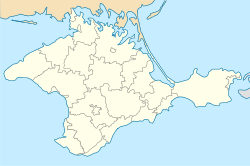| Kirovske / Kirovs'ke / Kirovskoye Goncharovka (pre 1953)  | |||||||
|---|---|---|---|---|---|---|---|
| Kirovske, Crimea in Ukraine | |||||||
 Satellite imagery of Kirovske air base Satellite imagery of Kirovske air base | |||||||
  | |||||||
| Coordinates | 45°09′55″N 35°10′55″E / 45.16528°N 35.18194°E / 45.16528; 35.18194 | ||||||
| Type | Air Base | ||||||
| Site information | |||||||
| Operator | Russian Aerospace Forces | ||||||
| Site history | |||||||
| Built | 1950 (1950) | ||||||
| In use | 1950 - present | ||||||
| Airfield information | |||||||
| Identifiers | ICAO: URFJ | ||||||
| Elevation | 53 metres (174 ft) AMSL | ||||||
| |||||||
Kirovske (in US intelligence, Kirovskoye) (Russian: Кировское; Ukrainian: Кіровське) is a Russian Aerospace Forces base located in Kirovske Raion, near the town of Kirovske, in Russian occupied Crimea, Ukraine.
The base is home to a detachment of the 929th State Flight Test Centre named for V. P. Chkalov.
Kirovske was the primary anti-submarine warfare (ASW) test and development center for Soviet Naval Aviation, and it worked closely with the flight test center at Akhtubinsk.
An interceptor regiment, the 136 IAP (136th Fighter Aviation Regiment) at Kirovske operated the Sukhoi Su-9 (ASCC: Fishpot) in the 1960s and 1970s. These were last seen at Kirovske in August 1979 before the runway was closed for expansion in the early 1980s. Other aircraft such as the Mikoyan-Gurevich MiG-15 (ASCC: Fresco) and Sukhoi Su-7 (ASCC: Fitter) were known to be present at Kirovske in the 1970s.
The base was used by the 326th Fighter Aviation Regiment between 1950 and 1979.
In April 2024, the UK's Ministry of Defence (MoD) reported that Kirovske had Su-30 fighter decoys painted on its hardstands and that at least a dozen more Russian air bases had painted similar decoys. The MoD believed the decoys were a reaction to Ukrainian attacks following the Russian invasion of Ukraine.
See also
References
- MISSION 1034 22 JUNE - 1 JULY 1966 PART II, July 1, 1966, CREST: CIA-RDP99T01396R000300060001-4, Central Intelligence Agency, Washington, DC.
- "Russian Air Force - Kirovs'ke (--)". Scramble.nl. Retrieved 5 January 2023.
- NEW BEAR VARIANT AKHTUBINSK FLIGHT TEST CENTER, USSR, June 25, 1982, CREST: CIA-RDP82T00709R000101760001-2, Central Intelligence Agency, Washington, DC.
- ^ PHASEOUT OF FISHPOT IN APVO STRANYY AIRFIELDS USSR, February 1981, CREST: CIA-RDP81T00380R000100980001-5, Central Intelligence Agency, Washington, DC.
- OAK SUPPLEMENT PART 20 KH-9 MISSION 1207 11 NOVEMBER 1973 - 20 FEBRUARY 1974, May 1, 1974, CREST: CIA-RDP78T04752A001600010010-9, Central Intelligence Agency, Washington, DC.
- "326th Kerchenskiy twice Red Banner Fighter Aviation Regiment PVO". Soviet Armed Forces 1945-1991. Retrieved 5 January 2023.
- @DefenceHQ (April 2, 2024). "Latest Defence Intelligence update on the situation in Ukraine – 02 April 2024" (Tweet) – via Twitter.
- Saballa, Joe (2024-04-08). "Russia Painting Fighter Jet Decoys on Airfields Amid Heavy Losses: Intel". thedefensepost.com. Retrieved 2024-11-02.
| Airports in Crimea and Sevastopol | |||||||
|---|---|---|---|---|---|---|---|
| Civilian |
| ||||||
| Military airbases |
| ||||||
| Crimea is amidst an international dispute between Ukraine and Russia. | |||||||